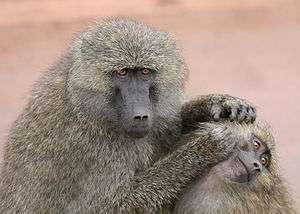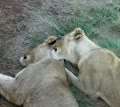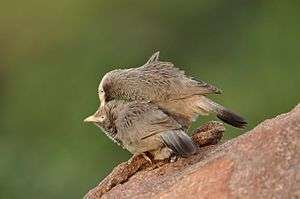Social grooming

In social animals, including humans, social grooming is an activity in which individuals in a group clean or maintain one another's body or appearance. A related term, allogrooming, indicates social grooming between members of the same species. Grooming is a major social activity, and a means by which animals who live in proximity may bond and reinforce social structures, family links, and build relationships. Social grooming also is used as a form of reconciliation and a means of conflict resolution in some species. Mutual grooming typically describes the act of grooming between two individuals, often as a part of social grooming, pair bonding, or a precoital activity.
It is a reuse of ordinary grooming behavior, a means of achieving hygiene and good health, in that an animal helping another animal to clean itself also is helping to form a social bond and trust between them.
In non-human animals
 Mutual grooming in ponies
Mutual grooming in ponies
 Social grooming in hyacinth macaws
Social grooming in hyacinth macaws One lion grooming another at the Rietvlei Nature Reserve
One lion grooming another at the Rietvlei Nature Reserve Allopreening in Yellow-billed Babbler
Allopreening in Yellow-billed Babbler Bonnet macaque allogrooming while infant suckles
Bonnet macaque allogrooming while infant suckles
Animals regularly clean themselves to keep their fur, feathers, scales, or other skin coverings in good condition. This activity - known as personal grooming, preening, or auto-grooming - promotes hygiene. Dead skin and foreign objects such as insects, ectoparasites, and leaves, dirt and twigs, are some of the items typically removed.
Many social animals groom each other, an activity known as social grooming, mutual grooming, or allo-grooming. Items removed during social grooming are identical to those removed by personal grooming. Social grooming also takes the form of stroking, scratching, and massaging.
Primates provide perhaps the best example of this activity, also known as monkey-bonding. The trust and bonding it builds is critical to group cooperation. Among primates, social grooming plays an important role in establishing and maintaining alliances and dominance hierarchies, for building coalitions, and for reconciliation after conflicts; it is also a resource that is exchanged for other resources, such as food and sex.[1][2][3][4] Primates groom socially in moments of boredom as well, and the act has been shown to reduce tension and stress.[5] It is often associated with observed periods of relaxed behaviour, and primates have been known to fall asleep while receiving grooming.[6]
Results of research shows that male crab-eating macaques will groom females in order to get sex. One study found that a female has a greater likelihood to engage in sexual activity with a male if he had recently groomed her, compared to males who had not groomed her.[7]
Vervet monkey siblings often have conflict over grooming allocation by their mother. Yet, grooming remains an activity that mediates tension and is low cost for alliance formation and maintenance.[8]
Other animals groom socially as well. These include insects,[9] birds,[10] ungulates,[11] and bats.[12] An example of a bird that socially grooms is the scaly-breasted munia. Whereas social grooming among primates has been very well-studied, less is known about social grooming in these other animals.
Mammals often perform social grooming. Domesticated animals, especially cats and dogs, will groom trusted humans as a sign of affection.
In humans
Only a few empirical studies of human social grooming exist.[13][14] Almost all the studies, except one recent cross-cultural study, rely on self-report survey and experimental methodology of adults, living primarily in the U.S. and other Western cultures. People report grooming romantic partners more than grooming people they have other types of relationships with such as family members, friends, and strangers. Grooming is associated with increased relationship satisfaction, trust, and experience of family affection while growing up. People who groom, as opposed to touching each other without grooming, are perceived to be better potential parents, more in love with the person they have groomed and more caring and committed to them.[15] Women, but not men, tend to think people who have groomed one another are romantically involved. People also think that if people who have groomed one another are romantically involved, they are in a long-term relationship rather than one that has just begun.[15]
A recent empirical study by Seinenu Thein-Lemelson (University of California, Berkeley) was the first to use ethological methods in order to examine cross-cultural differences in human grooming. Naturalistic data was collected through video focal follows with children during routine activities and then analyzed. The study indicates that there are significant cross-cultural differences in rates of caregiver-to-child grooming.[16]
Endocrine effects
Grooming stimulates the release of beta-endorphin, which is one physiological reason for why grooming appears to be relaxing.[17]
Additionally, an article published in 1997 concluded that an increase in maternal grooming resulted in a proportionate increase in Glucocorticoid receptors on target tissue in the neonatal rat. Additionally, it was found that the receptor number was altered because of a change in both serotonin and thyroid-stimulating hormone concentrations. An increase in the number of receptors might influence the amount of negative feedback on corticosteroid secretion and prevent the undesirable side effects of an abnormal physiologic stress response.[18]
Role of special neurons
A team of Caltech scientists showed that a particular type of neuron, identified by molecular markers, responds specifically to stroking.[19]
See also
| Look up social grooming in Wiktionary, the free dictionary. |
| Wikimedia Commons has media related to Social grooming. |
References
- ↑ Aureli, F., van Schaik, C., & van Hooff, J (1989). Functional aspects of reconciliation among captive long-tailed macaques (Macaca fascicularis). American Journal of Primatology, 19, 39-51.
- ↑ Lawick-Goodall, J. van. (1968). The behavior of free living chimpanzees in the Gombe Stream Reserve. Animal Behavior Monographs, 1, 161-311.
- ↑ de Waal, F. (1989). Peacemaking among primates. Cambridge, MA: Harvard University Press.
- ↑ Smuts, B., Cheney, D., Seyfarth, R., Wrangham, R., & Struhsaker, T. (1987). Primate Societies. Chicago: University of Chicago Press.
- ↑ Schino, G.; Scucchi, S.; Maestripieri, D.; Turillazzi, P.G. (1988), "Allogrooming as a tension-reduction mechanism: a behavioral approach", American Journal of Primatology, 16: 43–50, doi:10.1002/ajp.1350160106
- ↑ Smuts, Barbara (1985), Sex and Friendship in Baboons, New York: Aldine Publications, ISBN 978-0-202-02027-3, retrieved 28 April 2010
- ↑ Gumert, Michael D. (December 2007), "Payment for sex in a macaque mating market", Animal Behaviour, 74 (6): 1655–1667, doi:10.1016/j.anbehav.2007.03.009
- ↑ Lee, P.C. "Sibships: Cooperation and Competition Among Immature Vervet Monkeys." Primates. Vol 28(1) 47-59. 1987
- ↑ Moore, D.; Angel, J.E.; Cheeseman, I.M.; Robinson, G.E.; Fahrbach, S.E. (1995), "A highly specialized social grooming honey bee(Hymenoptera: Apidae)", Journal of Insect Behavior, 8 (6): 855–861, doi:10.1007/BF02009512
- ↑ Spruijt, B.M.; Van Hooff, J.A.; Gispen, W.H. (1992), "Ethology and neurobiology of grooming behavior", Physiological Reviews, 72 (3): 825–852, PMID 1320764
- ↑ Kimura, R. (1998), "Mutual grooming and preferred associate relationships in a band of free-ranging horses", Applied Animal Behaviour Science, 59 (4): 265–276, doi:10.1016/S0168-1591(97)00129-9
- ↑ Wilkinson, G.S. (1986), "Social grooming in the common vampire bat, Desmodus rotundus" (PDF), Animal Behaviour, 34 (6): 1880–1889, doi:10.1016/S0003-3472(86)80274-3
- ↑ Nelson, H. (2006), Human mutual grooming: an ethological perspective on its form and function
- ↑ Nelson, H. (2007), Encoding and decoding mutual grooming: Communication with a specialized form of touch
- 1 2 Nelson, Holly and Geher, Glenn. (2007-09-15) Mutual Grooming in Human Dyadic Relationships: An Ethological Perspective Springer Link. Retrieved on 2010-09-08
- ↑ Thein-Lemelson, Seinenu (February 2015). "Grooming and cultural socialization: A mixed-method study of caregiving practices in Burma (Myanmar) and the United States". International Journal of Psychology. 50 (1): 37–46. doi:10.1002/ijop.12119. PMC 4320772
 .
. - ↑ Keverne, E.B.; Martensz, N.D.; Tuite, B. (1989), "Beta-endorphin concentrations in cerebrospinal fluid of monkeys are influenced by grooming relationships", Psychoneuroendocrinology, 14 (1–2): 155–161, doi:10.1016/0306-4530(89)90065-6, PMID 2525263
- ↑ Sapolsky, Robert M. (September 1997), "The Importance of a Well-Groomed Child", Science, 277 (5332): 1620–1621, doi:10.1126/science.277.5332.1620, PMID 9312858
- ↑ Vrontou, S.; Wong, A. M.; Rau, K. K.; Koerber, R.; Anderson, D. J. (2013), "Genetic identification of C fibres that detect massage-like stroking of hairy skin in vivo", Nature, 493 (7434): 669–673, doi:10.1038/nature11810
Further reading
- Aureli, F., van Schaik, C., & van Hooff, J (1989). "Functional aspects of reconciliation among captive long-tailed macaques (Macaca fascicularis)". American Journal of Primatology. 19: 39–51. doi:10.1002/ajp.1350190105.
- Lawick-Goodall, J. van. (1968). "The behavior of free living chimpanzees in the Gombe Stream Reserve". Animal Behaviour Monographs. 1: 161–311. doi:10.1016/S0066-1856(68)80003-2.
- de Waal, F. (1989). Peacemaking among Primates. Cambridge, MA: Harvard University Press.
- Smuts, B., Cheney, D., Seyfarth, R., Wrangham, R., & Struhsaker, T. (1987). Primate Societies. Chicago: University of Chicago Press. ISBN 9780226767161.
- Schino, G.; Scucchi, S.; Maestripieri, D.; Turillazzi, P.G. (1988). "Allogrooming as a tension-reduction mechanism: a behavioral approach". American Journal of Primatology. 16: 43–50. doi:10.1002/ajp.1350160106.
- Smuts, Barbara (1985). Sex and Friendship in Baboons. New York: Aldine Publications. ISBN 978-0-202-02027-3. Retrieved 28 April 2010.
- Gumert, Michael D. (December 2007). "Payment for sex in a macaque mating market" (PDF). Animal Behaviour. 74 (6): 1655–1667. doi:10.1016/j.anbehav.2007.03.009.
- Lee, P.C. (1987). "Sibships: Cooperation and Competition Among Immature Vervet Monkeys". Primates. 28 (1): 47–59. doi:10.1007/BF02382182.
- Moore, D.; Angel, J.E.; Cheeseman, I.M.; Robinson, G.E.; Fahrbach, S.E. (1995). "A highly specialized social grooming honey bee (Hymenoptera: Apidae)". Journal of Insect Behavior. 8 (6): 855–861. doi:10.1007/BF02009512.
- Spruijt, B.M.; Van Hooff, J.A.; Gispen, W.H. (1992). "Ethology and neurobiology of grooming behavior". Physiological Reviews. 72 (3): 825–852. PMID 1320764.
- Kimura, R. (1998). "Mutual grooming and preferred associate relationships in a band of free-ranging horses". Applied Animal Behaviour Science. 59 (4): 265–276. doi:10.1016/S0168-1591(97)00129-9.
- Wilkinson, G.S. (1986). "Social grooming in the common vampire bat, Desmodus rotundus" (PDF). Animal Behaviour. 34 (6): 1880–1889. doi:10.1016/S0003-3472(86)80274-3.
- Nelson, H. (2006). Human mutual grooming: an ethological perspective on its form and function.
- Nelson, H. (2007). Encoding and decoding mutual grooming: Communication with a specialized form of touch.
- Nelson, Holly and Geher, Glenn (2007-09-15). "Mutual Grooming in Human Dyadic Relationships: An Ethological Perspective". Current Psychology. 26 (2): 121–140. doi:10.1007/s12144-007-9009-3.
- Keverne, E.B.; Martensz, N.D.; Tuite, B. (1989). "Beta-endorphin concentrations in cerebrospinal fluid of monkeys are influenced by grooming relationships". Psychoneuroendocrinology. 14 (1–2): 155–161. doi:10.1016/0306-4530(89)90065-6. PMID 2525263.
- Sapolsky, Robert M. (September 1997). "The Importance of a Well-Groomed Child". Science. 277 (5332): 1620–1621. doi:10.1126/science.277.5332.1620. PMID 9312858.
- Vrontou, S.; Wong, A. M.; Rau, K. K.; Koerber, R.; Anderson, D. J. (2013). "Genetic identification of C fibres that detect massage-like stroking of hairy skin in vivo". Nature. 493 (7434): 669–673. doi:10.1038/nature11810.